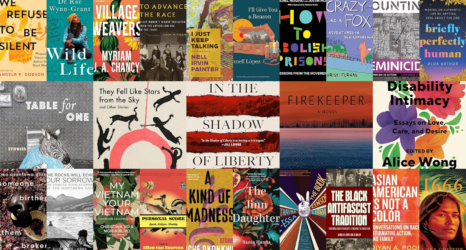You may know Rebecca Coffey’s science journalism from magazines like Scientific American and Discover, where she has proven herself as a teller of real-life tales that pop with quirky humor. Now she’s done herself one better in her debut novel, Hysterical: Anna Freud’s Story. It’s the fact-based, fictional autobiography of Sigmund Freud’s purportedly lesbian daughter, and it’s as funny and occasionally frightening as the title hints. These days, as states follow New Jersey and California in moving to ban gay conversion therapy (a/k/a reparative therapy) on minors, Hysterical is particularly timely.
In Hysterical, young Anna Freud receives an intensive gay conversion therapy from her famous father. According to Coffey, the analysis actually happened. At the time, Sigmund was universally acknowledged as the leading expert on sexuality, and he considered lesbianism to be a highway to mental illness that, fortunately, was curable by psychoanalysis.
But the analysis never should have happened, and not just because conversion therapy is pointless and cruel. As Sigmund defined psychoanalysis, it depends on a parsing of mutually erotic feelings that inevitably develop between analyst and patient.
Um, so just how does one do that ethically with one’s own daughter?
That’s the question that Hysterical takes on with high drama. Anna was 23 when her analysis began; the year was 1918. She had an intelligence that her father considered mannish. And she had violent fantasies during masturbation that he wanted to address.
“In reality, that first stretch of six-night-a-week analysis lasted two years,” says Coffey in my interview with her. “A second, briefer analysis followed later.”
In Hysterical, Anna’s analytic sessions offer marvelous perspective on the historical roots of gay conversion therapy. As a matter of historical fact, Sigmund agreed with most medical experts of his time that both masturbation and lesbianism were symptoms of hysteria, the illness of uncontrollable emotion that, a few decades before, had allegedly caused millions of women in Europe to faint, twitch, talk in tongues and become paralyzed. As far as Sigmund was concerned, his daughter suffered embarrassingly. What undoubtedly deepened his chagrin was that he believed lesbianism is always—always—the fault of the father.
Hysterical recounts how even the world’s most acclaimed psychoanalyst is unable to cure the debility he thinks he has wrought on his dearest daughter. Yes, Anna tolerates analysis. And ever the good daughter, she follows in her father’s professional footsteps. She cares for him as he ages, and after he dies she bears his intellectual seed into the world, never once questioning his wisdom about masturbation, lesbianism or hysteria.
Privately, though, she enjoys a 54-year relationship with Dorothy Burlingham, heir to the Tiffany fortune. They raise a family together. (Though some question whether they were physically intimate, even Burlingham’s grandson, Michael Burlingham, is “convinced that they were lesbians.”)
In addition to being child psychoanalysts (Dorothy takes her training from both Sigmund and Anna), Anna and Dorothy are humanitarians. Fleeing the Nazis, the Freud family settles in Hampstead, a suburb of London. There, during the London Blitz, the two women establish a war nursery that provides safe and loving haven to about 100 children made homeless by the bombing. At war’s end, they take in child survivors of Treblinka, a Nazi extermination camp in Poland.
“All real,” Coffey says.
But as laden with fact as Hysterical is, in writing it Coffey has flexed her funny muscles and her knack for spectacle and sweep. She explains,
The family apartment in Vienna and the family home in Hampstead were filled with patients, psychoanalysts and cultural figures that were great fun to describe and place in tense, historical context.
Austrian psychiatrist Otto Gross, for example, was an early Freud adherent as well as a nudist, an avid promoter of bisexual free love and cofounder of a pan-European society called The Great Unwashed. He was also a morphine addict.
“Really,” says Coffey. “Really.”
Perhaps Sigmund’s favorite analytic patient ever, Princess Marie Bonaparte was a descendent of Emperor Napoleon I and the wife of Prince George of Greece. She was also the patient of whom Freud asked his most famous question, “What do women want?” The Princess organized the Freuds’ escape from Nazi Vienna. And she was so dedicated to Sigmund that she had her clitoris surgically repositioned to explore his ideas about clitoral vs. vaginal orgasms.
“Really.”
Ernest Jones, a Welsh neurologist and a dear friend of Sigmund’s, and was three times dismissed from positions at hospitals for sexual misconduct; twice the complainants were children. Yet Sigmund arranged for him to chaperone Anna on her secondary school graduation trip to England.
“Yep.”
There’s also an attempted murder plot in Hysterical, confusion about recovered memory and a lovely patient who is a chronic masturbator and whose face is surgically butchered after Sigmund allows his best friend to convince him that the seat of sexuality in women is the nose.
“Well,” says Coffey,”there’s always some fiction in a historical novel. But the nose really was destroyed….”
This is an imaginative book of excruciating private lives lived on an enormous world stage. Through it all, Anna gives herself emotional perspective by drawing on the deep well of lowbrow humor that her father loved and that, according to Coffey, seems to have been part of Freud family culture. Coffey explains,
He inherited Yiddish humor from his parents and grandparents. But Sigmund himself could be very funny. His wife Martha and her sister Minna were Sigmund’s sister-wives. Minna moved in after Martha declared herself done with sex. The family situation remained pretty stable, and he summed it all up with an original quip: ‘A wife is like an umbrella. Sooner or later you take a cab.’ It’s subtle but funny, considering there’s so much veiled hostility in it.
And what about the hostility of Anna’s violent fantasies? Was this a manifestation of her father’s anger? Did the historical Anna actually have them? Says Coffey,
Anna and Sigmund both wrote about those fantasies, so we know they were a primary topic of her analysis. The child was being beaten not for misbehavior but for an inadvertent mistake. And Anna freely acknowledged being the beaten child. I hope that she eventually realized that her father was the enraged man and that, for at least a while in her long life, the scene of the beating was her gay conversion analysis, where Sigmund relentlessly punished her for the ‘mistake’ of homosexuality.
Today gay conversion therapy is more of a wing-nut brutality than Sigmund Freud ever imagined, with shaming, electroshocks and social skills training that encourages men, for example, to stop lisping and avoid musical comedies. Coffey points out that
Freud set in motion a honeycomb of prejudices. Homosexuality, which had once been thought of as acceptably normal in Vienna, suddenly seemed alien. It’s ironic that Freud himself seems privately to have overcome his own prejudices. As Anna incorporated Dorothy into the Freud family, people would raise their eyebrows about them. And publicly Sigmund remained a huge proponent of conversion therapy. But privately he said things like, ‘Oh, they’re fine. Just let them be.’
I recommend this book for an engrossing and highly informing read of lives and a legacy that still have repercussions today.





